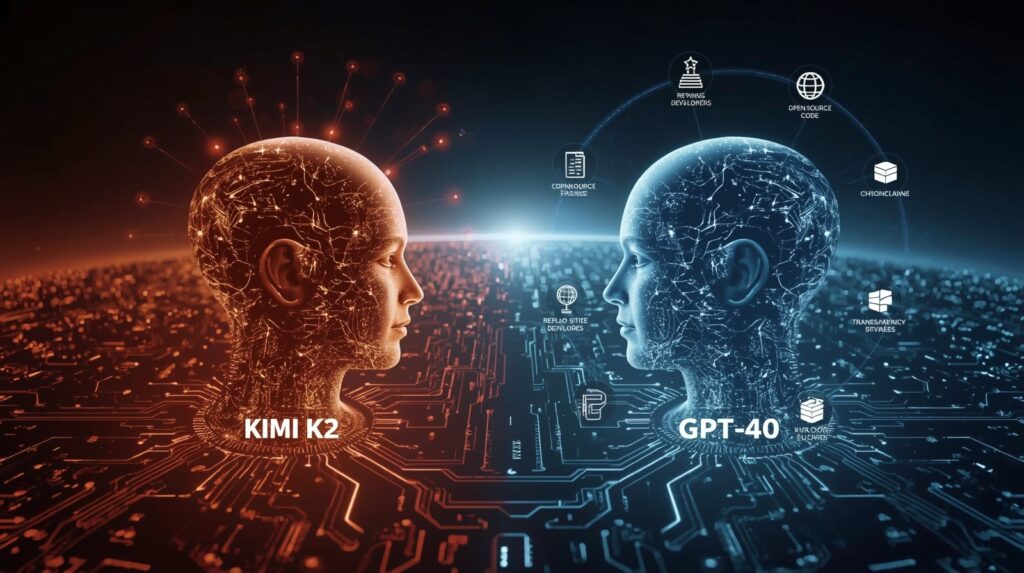
AI CERTS
5 months ago
Kimi K2: Moonshot AI’s Open-Source Model Reshapes AI Race
Kimi K2 is tailored for advanced reasoning, high-level coding, and autonomous agentic workflows, making it one of the most powerful open-source AI tools available in 2025. Its release represents not only a technological milestone but also a strategic geopolitical move amid the global AI arms race.

🧠 What is Kimi K2—and Why It Matters?
Kimi K2 is a generative AI model trained to understand and generate natural language, solve complex computational problems, and simulate autonomous decision-making behaviors. While Moonshot AI hasn’t yet revealed full technical documentation, early access reveals major upgrades over its predecessor, Kimi Chat, which had already become a go-to assistant for millions of Chinese users.
Key Features of Kimi K2:
- 🧠 Agentic AI: Kimi K2 can simulate multi-step decision-making—ideal for automation, simulations, and AI research.
- 💻 Enhanced Coding Abilities: Supports multiple programming languages with accurate logic and structure.
- 🌍 Multilingual Understanding: Optimized for Chinese and English, expanding access for global devs.
- 🔓 Open-Source Licensing: Available on public repositories, enabling unrestricted community use and improvement.
Moonshot AI claims that Kimi K2 is not just a model—it’s a platform for collaborative AI development in an era where transparency and reproducibility are in high demand.
The Global Context: China’s Strategic AI Push
Kimi K2’s release signals China’s broader commitment to open-source innovation in AI, standing in contrast to the closed-source approaches of many Western firms. This is a strategic pivot, especially as global regulators scrutinize AI safety, privacy, and transparency.
In 2024, Moonshot AI captured public attention when its Kimi Chat model surpassed 15 million users in China. But with Kimi K2, the company isn't just appealing to users—it’s targeting the global developer ecosystem, research labs, and startups seeking transparent and cost-effective alternatives to proprietary LLMs.
Stay ahead in the evolving open-source AI space:
🧠 AI Developer Certification
📘 If Kimi K2 sparked your curiosity, you’ll want to read our breakdown of AI Stocks Drive Surge in Global Equity Fund Inflows
⚖️ The Competitive Landscape: Where Kimi K2 Stands
| Model | Open Source | Agentic Capabilities | Target Market | Region |
|---|---|---|---|---|
| Kimi K2 | ✅ Yes | ✅ Advanced | Developers, researchers | China |
| GPT-4o | ❌ No | ✅ Yes | Enterprises, consumers | USA |
| Claude 3 | ❌ No | ✅ Moderate | Safe AI use cases | USA |
| DeepSeek V2 | ✅ Yes | ✅ Moderate | Education, data science | Global |
While many major players retain closed access to their most powerful models, Moonshot’s approach aims to build trust by putting full capabilities into the public domain, reinforcing a growing belief that the future of AI should be open, collaborative, and auditable.
📉 Challenges Ahead
Despite its strong feature set and global buzz, Kimi K2 faces tough hurdles. These include:
- Maintaining model safety and moderation at scale
- Competing with U.S.-based LLMs that have greater compute backing
- Earning trust beyond China's domestic developer base
- Avoiding overuse of misinformation or copyright-sensitive content
Still, experts believe its open-source structure could become a critical tool for AI democratization—especially for startups and academic researchers locked out of costly API-based solutions.
🧠 Final Takeaway
With the launch of Kimi K2, Moonshot AI isn’t just making a technological statement—it’s planting a flag in the ground for transparent, accessible AI development. In doing so, it challenges the dominance of American tech giants and pushes the global AI community closer to a future where innovation is open to all.



